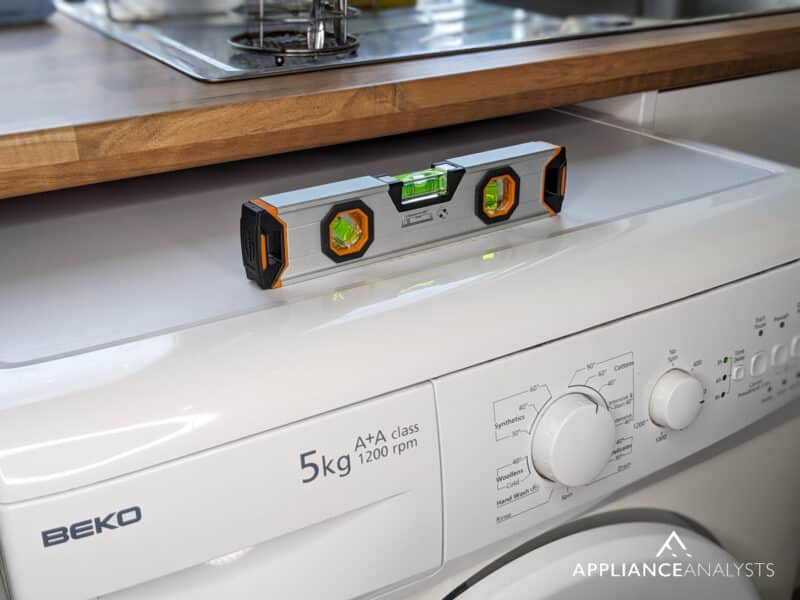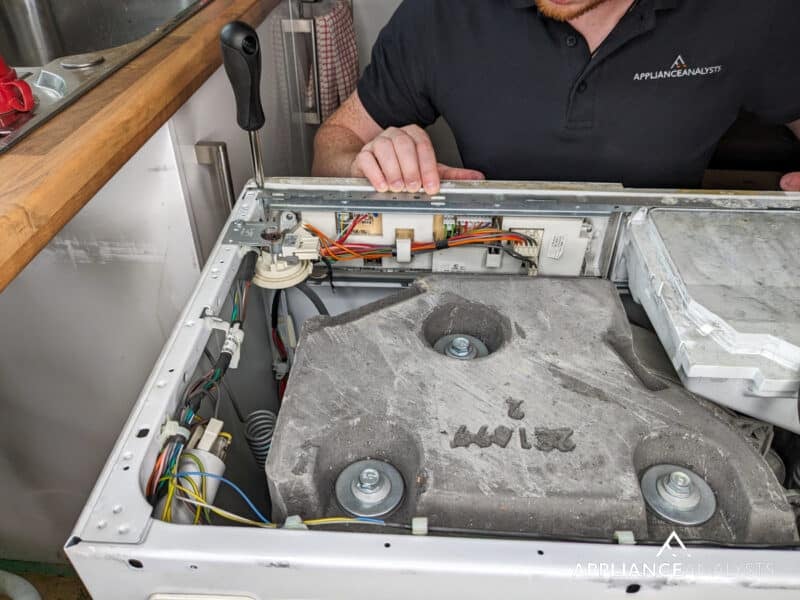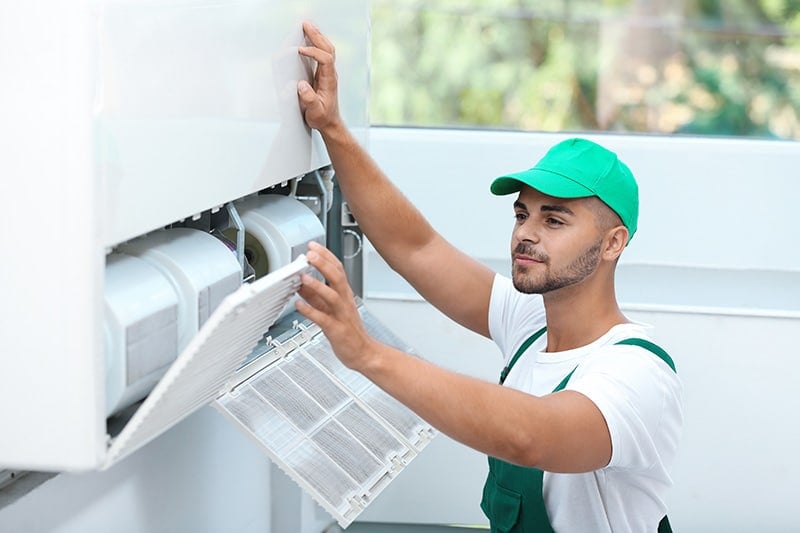We've independently reviewed this article to make sure it's as accurate as we can make it.
To find out more about our article creation and review process, check out our editorial guidelines.
Does your washer keep turning off, and it’s making your laundry pile up?
That sucks! Laundry days are not the most exciting part of the week, but they’re necessary to keep our clothes fresh and clean.
I know how annoying it can be to have your washer keep turning off whenever you’re trying to do a load of laundry – especially on a super busy day. But don’t worry; you’ve come to the right place for answers. Below, you’ll find a list including the 5 most common reasons why you’re in such a situation and some simple fixes for each one.
When your washer keeps turning off, it can be due to a power source issue, the washer being unbalanced, various Error Codes, or a fault with the water temperature sensor. The issue can also be present as a result of a faulty mainboard/control panel.
Keep reading to keep your washer on and get that laundry done!
Why Your Washer Won’t Stay On
When your washer keeps turning off, many factors can be at play. From what I’ve seen over the years, depending on the washer model you own (front load or top load), some issues are more common than others, and even the solutions can vary.
Here are some things I recommend you consider when trying to get your washer back to normal.
#1 A Bad Power Source
First, let’s consider a bad power source as a possible reason why your washer keeps turning off.
It’s important to rule out external factors before considering other washer-related problems, such as poor balancing or faulty components. I’ve found that having a faulty wall outlet cause your washer to keep turning off is quite common.
Addressing any issues with your home’s power supply is not only essential to ensure that your washer works normally and doesn’t sustain damage, but also to prevent further electrical difficulties in general.
Solution: The simplest way to rule out or confirm a bad wall outlet as the culprit for your current situation is to get an extension cord and plug the washer into a different outlet on a different circuit.
To know whether the new outlet is linked to a different circuit in your breaker, plug a lamp into it, then turn the breaker supplying power to your washer’s original wall outlet and see if the lamp stays on. If so, the new outlet is running on a separate circuit and is safe for testing your washer.
Once your washer is plugged into the new outlet, try running a laundry cycle and see if it stays on throughout the entire process. If so, the original outlet is at fault.
For now, you can keep using your washer with the extension. However, I strongly advise you to call a professional electrician to test the suspicious outlet and nip any electrical problems in the bud.
#2 Balancing Issues
The next thing to double-check when your washer keeps turning off is that the appliance is perfectly balanced and level.
Although poor balancing can cause issues in both front and top load washers, the latter can be much more problematic. Washers are built with many safety measures and specific conditions that must be met for them to work. If your washer can’t balance itself during a cycle or before starting one, it’s not surprising that it fails to stay on.

Solution: With your washer’s basket empty, push down on the basket to test the suspension rods. If you notice there’s excessive bouncing rather than a steady movement, the rods might be faulty.
You can replace the suspension rods yourself if you’re feeling up to the task. Expect to pay anywhere from $30-$60 for a 4-rod kit (at least for Whirlpool or Maytag washers). Alternatively, you can buy individual suspension rods for about $10-$25 (Samsung or LG).
When one suspension rod fails, all 4 must be replaced, so please bear that in mind when considering the cost of repairs. There are tons of online resources you can check out for detailed instructions on how to replace your washer’s suspension rods.
#3 A Persisting Error Code
Washer Error Codes can help you determine why yours keeps turning off, as well as pinpoint any other issues and correct them before it’s too late.
Most modern appliances will show Error Codes when something is not working properly inside them. Whether it’s a bad power source, a broken component, or even overheating, your appliances will let you know if an issue is present.
Every washer manufacturer has different Error Codes for different issues, so please bear that in mind when trying to find what the one you’re getting means. From what I’ve seen, you can find the specific Error Codes for your washer in your User Manual, so give it a good read-through if you can.
Provided you no longer have the manual, please refer to our free resource below to find it.
Solution: Set your phone to record your washer’s display as it runs. Go through the video and try to spot any Error Codes that appear.
Watch out for Error Codes, such as “UL” or “UB” as they mean your washer is unbalanced. The type of Error Code you get will depend on your washer’s brand.
If any other Error Code appears, you can either refer to your User Manual or go to Google and search for “[Your Washer’s Brand and Model] + [The Error Code You’re Getting]“. You should be able to find exactly what the Error Code means online.
#4 A Faulty Water Temperature Sensor
Moving on, a faulty water temperature sensor can also be causing your washer to keep turning off.
The water temperature sensor is a key component inside your washer that senses the incoming water’s temperature to determine how hot or cold the laundry cycle must be in order to stick to the washing program you’ve dialed in.
When the sensor fails, it can’t detect the incoming water’s temperature accurately and might think there’s a mismatch between the program settings and the actual temperature, causing the washer to shut off.
Solution: Look closely at the water temperature during a cycle. If you’ve selected a washing cycle with cold water but notice there’s hot water going into the washer instead, it’s a clear indication that the water temperature sensor is on the fritz.
Naturally, the opposite also applies.
A faulty water temperature sensor will have to either be repaired or replaced. If you’re unsure how to replace your washer’s water temperature sensor, please get in touch with a certified washer technician to take care of the job.
#5 A Faulty Mainboard/Control Board
The last possible reason why your washer keeps turning off is that the Mainboard, also known as “Control Board” is faulty.
Your washer’s Mainboard is what allows it to process your inputs, communicate with its internal components, and determine how laundry cycles should go. In other words, the Mainboard is your washer’s brain, and as such, it’s its most important component.

When the Mainboard fails, your washer will have difficulty staying on, as it might have trouble communicating with the water temperature sensor, the timer, and the system responsible for posting Error Codes.
Solution: Sadly, repairing/replacing a washer’s Control Board is neither simple nor cheap. In most cases, you’re looking at anywhere from $250-$400 or more if your washer is a high-end model. Additionally, you’ll have to pay a technician to do the repair, which can further increase your expenses.
My usual advice for replacing your washer’s Mainboard is to weigh the cost of repairs vs. the original price of your washer and the cost of buying a new one. I tend to find that if the cost of repairs is equal to or higher than 50% of the price of a new washer with similar features, you’re better off going shopping.
Keeping Your Washer On
That about covers it!
When your washer keeps turning off for no apparent reason, a simple task, such as doing laundry for the week, can be annoying and difficult.
Luckily, as I hope this piece has helped you better understand, addressing the most common causes behind a washer that keeps turning off can be easy and quick. More often than not, something simple, like ensuring the washer is balanced properly and checking your User Manual for the meaning of a specific Error Code, will do the trick.
Thanks for reading. If this article was useful and answered your most burning questions, please check out our other resources and free guides below and consider subscribing to our newsletter.
Have a wonderful week!
-Craig.









